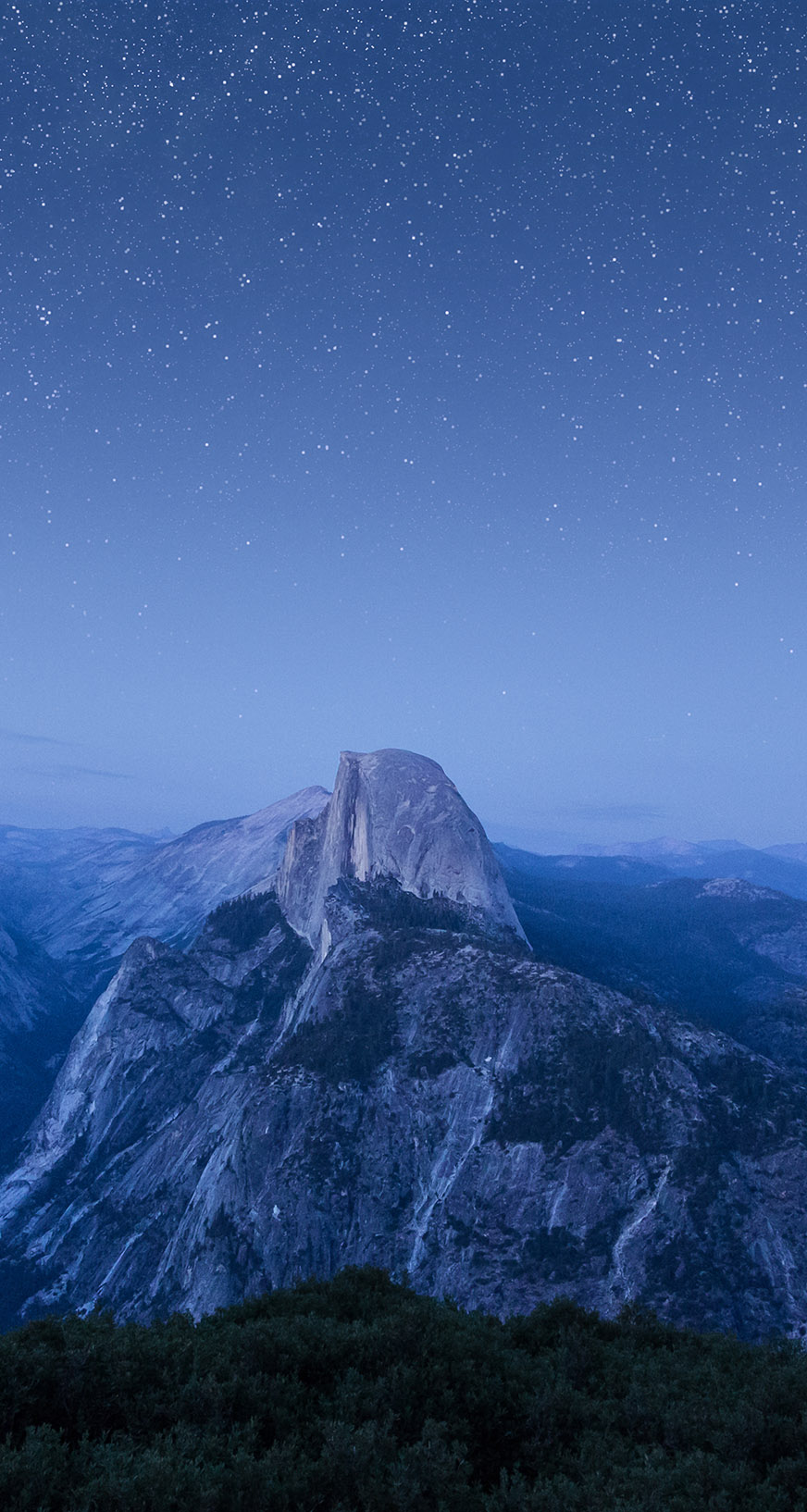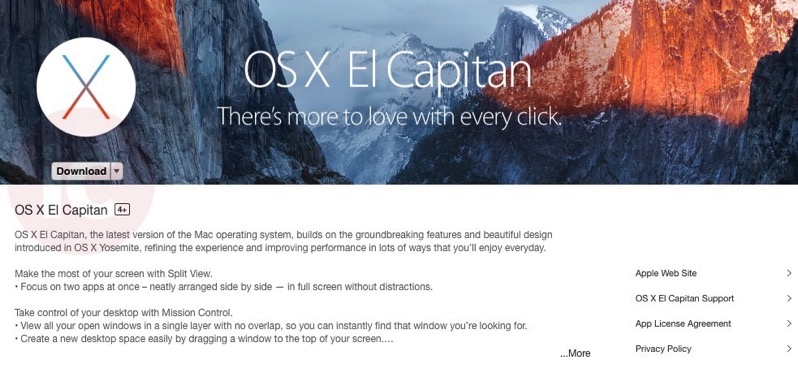These advanced steps are primarily for system administrators and others who are familiar with the command line. You don't need a bootable installer to upgrade macOS or reinstall macOS, but it can be useful when you want to install on multiple computers without downloading the installer each time.
Download macOS
Jun 19, 2020.
Find the appropriate download link in the upgrade instructions for each macOS version:
macOS Catalina, macOS Mojave, ormacOS High Sierra
Installers for each of these macOS versions download directly to your Applications folder as an app named Install macOS Catalina, Install macOS Mojave, or Install macOS High Sierra. If the installer opens after downloading, quit it without continuing installation. Important: To get the correct installer, download from a Mac that is using macOS Sierra 10.12.5 or later, or El Capitan 10.11.6. Enterprise administrators, please download from Apple, not a locally hosted software-update server.
OS X El Capitan
El Capitan downloads as a disk image. On a Mac that is compatible with El Capitan, open the disk image and run the installer within, named InstallMacOSX.pkg. It installs an app named Install OS X El Capitan into your Applications folder. You will create the bootable installer from this app, not from the disk image or .pkg installer.

Use the 'createinstallmedia' command in Terminal
- Connect the USB flash drive or other volume that you're using for the bootable installer. Make sure that it has at least 12GB of available storage and is formatted as Mac OS Extended.
- Open Terminal, which is in the Utilities folder of your Applications folder.
- Type or paste one of the following commands in Terminal. These assume that the installer is still in your Applications folder, and MyVolume is the name of the USB flash drive or other volume you're using. If it has a different name, replace
MyVolumein these commands with the name of your volume.
Catalina:*
Mojave:*
High Sierra:*
El Capitan: - Press Return after typing the command.
- When prompted, type your administrator password and press Return again. Terminal doesn't show any characters as you type your password.
- When prompted, type
Yto confirm that you want to erase the volume, then press Return. Terminal shows the progress as the bootable installer is created. - When Terminal says that it's done, the volume will have the same name as the installer you downloaded, such as Install macOS Catalina. You can now quit Terminal and eject the volume.
* If your Mac is using macOS Sierra or earlier, include the --applicationpath argument, similar to the way this argument is used in the command for El Capitan.
Use the bootable installer
After creating the bootable installer, follow these steps to use it:
- Plug the bootable installer into a compatible Mac.
- Use Startup Manager or Startup Disk preferences to select the bootable installer as the startup disk, then start up from it. Your Mac will start up to macOS Recovery.
Learn about selecting a startup disk, including what to do if your Mac doesn't start up from it. - Choose your language, if prompted.
- A bootable installer doesn't download macOS from the Internet, but it does require the Internet to get information specific to your Mac model, such as firmware updates. If you need to connect to a Wi-Fi network, use the Wi-Fi menu in the menu bar.
- Select Install macOS (or Install OS X) from the Utilities window, then click Continue and follow the onscreen instructions.
Learn more
For more information about the createinstallmedia command and the arguments that you can use with it, make sure that the macOS installer is in your Applications folder, then enter this path in Terminal:
Catalina:
Mojave:
High Sierra:
El Capitan:

Here you can get download links for macOS Old and Latest Releases. Previously macOS was called as OS X or Mac OS X.
These links are helpful when
- You do not have access to internet on your main computer.
- You want to download macOS from Windows or Linux OS.
- You want to download macOS without AppStore
1Download Mac OS X Snow Leopard

Mac OS X Snow Leopard (version 10.6) is the seventh major release of Mac OS X (now named macOS), Apple’s desktop and server operating system for Macintosh computers.
2Download Mac OS X Lion
Mac OS X Lion (version 10.7) is the eighth major release of Mac OS X (now named macOS), Apple’s desktop and server operating system for Macintosh computers.
3Download OS X Mountain Lion
Mac OS X Mountain Lion (version 10.8) is the nineth major release of Mac OS X (now named macOS), Apple’s desktop and server operating system for Macintosh computers. OS X Mountain Lion brings a lot of great things from iPhone, iPad, and iPod touch to the Mac. You can send iMessages. Get your Mac in on Game Center. Receive notifications. And more. And with iCloud, now your Mac works even better with your iOS devices.
4Download OS X Mavericks
OS X Mavericks (version 10.9) is the tenth major release of Mac OS X (now named macOS), Apple’s desktop and server operating system for Macintosh computers. OSX Mavericks is an impressive operating system which has come up with lots of new features and updates. With OSX Mavericks you can now take the whole world on your desktop. You can easily look up for different directions and then finally send them to iPhone for recognition of your voice. You can get local points of interests like photos, restaurants with phone numbers etc.
5Download OS X Yosemite
Mac OS X Yosemite (version 10.10) is the eighth major release of Mac OS X (now named macOS), Apple’s desktop and server operating system for Macintosh computers.
6Download OS X EL Capitan
OS X El Capitan (version 10.11) is the twelfth major release of OS X (now named macOS), Apple Inc.’s desktop and server operating system for Macintosh computers. It is the successor to OS X Yosemite and focuses mainly on performance, stability, and security. Following the Northern California landmark-based naming scheme introduced with OS X Mavericks, El Capitan was named after a rock formation in Yosemite National Park, signifying its goal to be a refined version of Yosemite. El Capitan is the final version to be released under the name OS X; its successor, Sierra, was announced as macOS Sierra.
7Download macOS Sierra
macOS Sierra (version 10.12) is the thirteenth major release of macOS (previously OS X), Apple Inc’s desktop and server operating system for Macintosh computers. The successor to OS X El Capitan, it is the first version of the operating system issued under the June 2016 rebranding as macOS. Sierra is named after California’s Sierra Nevada mountain range. The mountain in the default desktop picture is Lone Pine Peak . Its major new features concern Continuity , iCloud , and windowing, as well as support for Apple Pay and Siri .
8Download macOS High Sierra
Download Mac Os X 11
macOS High Sierra (version 10.13) is the fourteenth major release of macOS, Apple Inc.’s desktop and server operating system for Macintosh computers. The successor to macOS Sierra, it was announced at WWDC 2017 on June 5, 2017.
9Download macOS Mojave
Mac Os El Capitan Download Google Drive
macOS Mojave (version 10.14) is the fifteenth major release of macOS, Apple Inc’s desktop operating system for Macintosh computers. The successor to macOS High Sierra, it was announced at WWDC 2018 on June 4, 2018. It brings several iOS apps to the desktop including Apple News, Voice Memos, and Home introduces a Dark Mode and is the final version of macOS to support 32-bit apps.
10Download macOS Catalina
Os X El Capitan 10.12
macOS Catalina (version 10.15) is the sixteenth major release of macOS, Apple’s desktop operating system for Macintosh computers. It is the successor to macOS Mojave and was announced at WWDC 2019 on June 3, 2019. Catalina is the first version of macOS to exclusively support 64-bit applications.